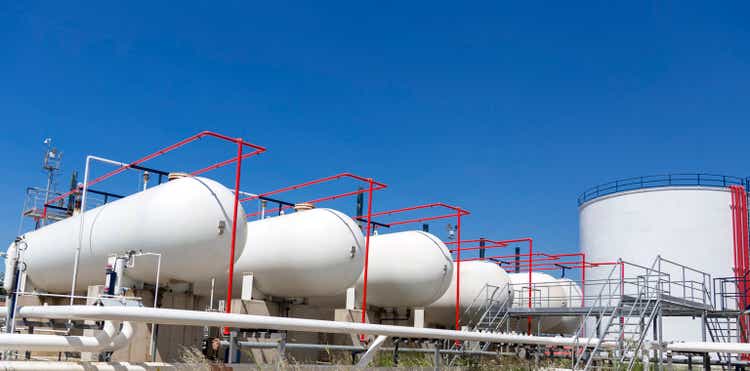soner tuncer
The Quarter
Enterprise Products Partners (NYSE:EPD) reported a record quarter with the strongest quarterly results ever from several operating segments, particularly natural gas processing and octane enhancement. Net income attributable to unitholders increased to $1.4 billion. More importantly, income per unit increased 30% to $0.64 from $0.50. Most important I believe for most readers on this site, distributable cash flow excluding asset sales increased 25% to $2 billion from $1.6 billion. This increased cash flow resulted in 1.9x coverage of the company’s $0.475/unit quarterly distribution ($1.90/unit annualized and over 7% yield). I lay out the pertinent summary financial information in the table below.
| Three Months Ended June 30, | Three Months Ended June 30, | |
|
($ in millions, except per unit amounts) |
2022 |
2021 |
|
Operating income |
$1,764 |
$1,492 |
|
Net income |
$1,440 |
$1,146 |
|
Fully diluted earnings per common unit |
$0.64 |
$0.50 |
|
Total gross operating margin |
$2,362 |
$2,062 |
|
Adjusted EBITDA |
$2,418 |
$2,008 |
|
Adjusted CFFO |
$2,092 |
$1,694 |
|
Adjusted FCF |
$1,718 |
$1,086 |
|
Distributable Cash Flow |
$2,018 |
$1,599 |
The company is busy integrating its acquisition of Navitas Midstream, which closed in the middle of the first quarter. Navitas helped drive the company’s strong natural gas gathering and processing results. For those who also follow Crestwood (CEQP), EPD’s strong results and focus on the natural gas gathering and processing business in the Permian legitimizes CEQP’s recent acquisitions of Sendero Midstream and First Reserves stake in Permian assets. EPD’s robust cash flows allowed it to repay $740 million of commercial paper issued to partially fund the acquisition of Navitas, keeping the balance sheet in pristine shape with over $4 billion of liquidity and allowing for easy funding of $383 million of quarterly capital expenditures ($301 million growth and $82 million of maintenance). Much of the company’s growth capital will be spent in the Permian over the next year at least.
Volumes were firm nearly across the board except for propylene. Much of the company’s gross operating margin growth came from the NGL Pipeline and Services segment, helped by higher NGL prices which averaged $1.06/gallon on a weighted basis and higher volumes. Curiously, the fractionization business reported a decline in margin despite higher volume. I believe the drop in margin was due to one-time items resulting from last year’s winter storms that benefitted last year’s second quarter.
Unit Repurchases
The company only bought back 1.4 million units for $35 million. I think this low repurchase activity disappoints some people. However, the company pointed out on the conference call that maintaining balance sheet flexibility allowed for the purchase of Navitas funded largely with cash and commercial paper without stressing the balance sheet at all. With the commercial paper repaid, the company is turning its attention to retiring about $350 million of its higher coupon (around 6%) sub notes and still plans to repurchase around $300 million of units in the back half of the year. Moreover, it recently raised its distribution, which is now 5.5% higher than last year.
Risks
As always with this company, its main exposure is to volumes and differentials, which allow for arbitrages on the system. The company was asked about the demand it is seeing across its system. It is seeing some weakness in its olefin markets but ethane, LPG and crude exports are at record levels thanks to strong worldwide demand and pricing. As I have written many times over the past year, I believe energy remains in a good supply/demand state globally. I see nothing on the horizon to disrupt EPD’s core businesses.
Conclusion
With a >7% distribution yield that is 1.9x covered leading to a >13.3% free cash flow yield, double digit underlying cash flow growth, a rock-solid balance sheet that is phenomenally positioned for a rising rate environment, and continued firepower to raise distributions and repurchase units, I continue to consider EPD as a core holding for any income investor with an allocation to energy. The units are up almost 15% (as of this writing) since I first published on this company last year. Distributions have pushed the total return over 20%. I continue to marvel that this company is trading below where it did pre-Covid. Given the growth in all cash flows, particularly per unit, it should be trading much higher than pre-Covid, which would mean over $30.


Be the first to comment